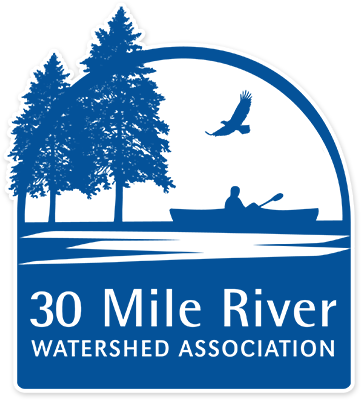All of the vegetation in and near the water forms an important ecosystem that is critical for not only the integrity of your shorefront, but for the wildlife that rely on it for survival and the overall health of your lake. Aquatic plants provide food and shelter for fish, birds, and other animals. Tall plants like bulrush and sedges, and large woody debris like the trunks of fallen trees, reduce the energy of wave action to minimize erosion and help maintain water quality.
Human impacts from shoreline development, and increased boat wakes from recreational use, can cause shoreline erosion and disrupt this valuable habitat.
Until recently, the most recommended and implemented action to address shoreline erosion was to install riprap, or angular rock, to armor and protect the shoreline where it meets the water. Riprap has been commonly used for shoreline erosion due to its relative ease of installation. However, recent research suggests that riprap shorelines are more often not effective in preventing erosion long-term and can have significant negative impacts to overall lake health. Why not riprap?
1. Not all undercut banks are bad. Historically, any undercut bank where soils had contact with the water was viewed as unstable and eroding. This is just not true. Even the most remote, undeveloped lake will have natural undercutting along the shoreline. We are now finding that many undercut shorelines are natural, stable, provide many habitat benefits, and do not require intervention with conventional riprap installations. Many of you know that the nutrient that poses the greatest risk to lakes and ponds is phosphorus – a nutrient naturally found in soil. We are now learning that phosphorus levels from undercut shorelines are often relatively low. Especially when compared to the high levels of phosphorus that are entering our lakes from watershed sources like eroding gravel camp roads, septics, and other shoreline development.
2. Alterations in the biological community within a lake or river can result. The installation of riprap leads to issues when this practice is the primary or only form of bank stabilization. The end result is a uniform bank or channel with no complexity or diversity. This means that there are no areas of vegetation either in or overhanging the water for fish, and other aquatic animals, to seek refuge. Replacing natural shoreline habitat with riprap takes habitat away from all aquatic critters and other shoreline-reliant animals.
3. Riprap shorelines can cause thermal pollution in lakes and rivers when unshaded rock soaks up sunlight and increases the water temperature around the site to levels unsuitable for fish and other aquatic species.
4. Riprap can act as a barrier for species that move between the water and upland habitats because it interrupts the establishment of a natural riparian zone and the point of interface between land and water.
5. Shoreline riprap can deflect energy to adjacent properties and shorelines. Since riprap is made of hard rock, it does not absorb wave energy but deflects it. Diverted wave energy from one property’s riprap shifts the energy to neighboring properties, often causing new erosion problems.
6. Riprap is not a cost-effective long term solution. Riprap also tends to suffer from structural integrity issues during and after winter ice and high-water events. Losing rocks to shifting ice, high water, or high flows, a riprap shoreline will soon begin to fail. Once the soil that the riprap is designed to protect is exposed, the damage continues as before its installation. This requires constant monitoring and maintenance, which ultimately becomes expensive and problematic.
For the reasons above, the Maine Department of Environmental Protection (Maine DEP) has updated their 319 grant policy which prohibits traditional riprap installations using 319 funding, and is now updating the Natural Resource Protection Act (NRPA) Chapter 305 permit standards to reflect the same policy.
Alternatives to riprap include nature-based solutions that interfere with the natural community as little as possible while providing long-term resilience. Each nature-based or ‘living’ shoreline solution will vary depending on several factors such as erosion source, soil stability, slope, groundwater inputs, and adjacent land uses among other considerations.
Examples of nature-based solutions to address shoreline erosion:
Human activities on the shoreline often exacerbate natural causes or erosion. Removal of or damage to shoreline vegetation is the leading cause of erosion on the lake shore. Remember, foot traffic alone is enough to damage the roots of trees and other plants! Furthermore, when development occurs near a lake, the shoreline buffer zone becomes less and less effective in trapping pollutants and treating stormwater that flows to the lake. For this reason, it’s recommended that upland best management practices (BMPs), like swales, rain gardens, runoff diverters, or infiltration trenches, be in place to manage upland runoff flow before pursuing a shoreline stabilization project.
Vegetated Buffer

Stone Toe and Bank Re-Vegetation

Live Staking

Photo Source: Vermont Bioengineering Manual: A Technical Manual for Lakeshore Contractors and Homeowners.
Fiber Coir Rolls and Vegetation

Encapsulated Soil Lifts

